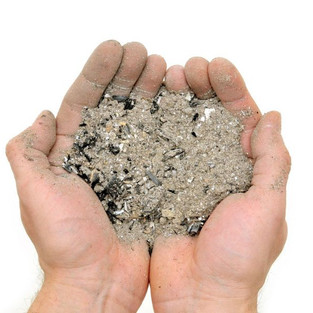Top 7 Things To Consider Before Spreading Pet Cremation Ashes
- Rooted Pet

- Mar 31, 2020
- 5 min read
For many people, the act of scattering a beloved pet's ashes brings peace, comfort and closure. It can symbolize the return of the pet to nature, or the release of their spirit to heaven. Before you head to your beloved pet's favorite park to spread the ashes, make sure that you understand the laws and regulations in your area. While there’s no specific national “scattering ashes law” in the United States, there are a number of rules and regulations that you may need to be aware of at the national, state, and local level.
1. Can I Spread Ash in a National Park?. If you plan to scatter the ashes of your loved on in a national park in the United States, most parks do allow this. You cannot simply scatter ashes anywhere, however – there are specific regulations.
You should request permission from the chief park ranger first.
A permit is usually required.
Cremains should only be scattered away from trails or other developed areas.
Environmentally or archeologically sensitive areas may be off limits.
Realistically, as long as you stay away from sensitive or populated areas, it’s unlikely that you’d be prosecuted for breaking “spreading ashes laws,” even if you don’t ask permission. It’s still illegal, however, and you could get into trouble.
2. What About Scattering Ashes on Private Property? You are free to scatter ashes anywhere on your own private property, but if someone else owns the land, you need to ask permission first. Either written or verbal permission is fine, but it may be a good idea to have a record of the agreement. If the property owner says no, find another location. Don’t try to secretly spread the ashes anyway. While there may be no specific cremation ashes laws that directly address this issue in your state, it’s trespassing and it’s illegal. You could face fines and even jail time.
3. Sports Stadiums and Amusement Parks Are Private Property. There is often a lot of confusion about the difference between public and private property. The local NFL stadium, for example, is private property, even though it may have been paid for, in part, by your tax dollars. There are many areas, including other sports stadiums, golf courses, amusement parks, and some museums, that have many visitors each year, but that does not make them public property.

This distinction is important, because you need to get permission before scattering ashes on private property. And if the location is a stadium or amusement park, your request is likely to be declined. In many cases, if you’re caught spreading ashes, the police will be called. Some individuals have been fined and sentenced to community service. In addition, many property owners will have the ashes removed and respectfully disposed of in another location – so while you may have spread your friend’s ashes at Disney World, chances are good that they won’t remain there.
4. Spreading Ashes at Sea Is Allowed.
According to the EPA, burial at sea of human remains – cremated or not – is permitted, but there are several scattering ashes laws and regulations that you need to follow:
Any type of remains, including ashes, can only be placed in the ocean 3 nautical miles from land or more.
Ashes can be scattered from a boat or airplane.
Only biodegradable urns may be used. Anything placed in the water must easily decompose in a marine environment.
You can release flowers or wreaths into the water, but they must decompose easily.
While a permit is not required, you must report the burial to the EPA within 30 days.
Pet cremains may not be spread at sea without a special permit.
It’s important to note that most rivers, ponds, and lakes are not subject to federal regulation, and therefore these scattering ashes laws do not apply. You need to contact the mortuary board, environmental agency, or health agency in the state where you want to spread the ashes to learn more about the relevant laws. Scattering ashes in inland waters is illegal in some states.
Many states also have spreading ashes laws that prohibit cremains from being scattered on beaches or shorelines. Some states, such as California, do permit it as long as you’re 500 yards from shore. If you’re in a relatively private area and don’t scatter the ashes in a place where they are likely to wash ashore and disturb other people, it’s unlikely that you would be arrested or charged for breaking this law – but it’s still illegal.
5. You May Be Allowed to Scatter Ashes on Uninhabited Public Land. This is another one of those spreading ashes laws that depends on the state where you live, so always check with the appropriate authorities first. Forests and other wilderness areas can be a lovely place to scatter ashes, but do so away from commonly used trails or other locations where you know people frequently visit or travel.
6. It May Be OK to Scatter Ashes in a Graveyard – But Maybe Not. First, you need to know if the graveyard is public or private property. If the cemetery is on private property, you need to ask permission. For public graveyards, ask the city or town that manages the property if there are any scattering ashes laws or regulations that forbid spreading ashes; some towns have banned the practice. An increasing number of private cemeteries actually offer “scattering gardens,” and may only allow ashes to be scattered there and only for a fee.
If you’re planning to spread the ashes on a grave or in a crypt, make sure that you speak to the individual’s immediate family (if possible) before doing so.
7. Be Considerate of Others. This is perhaps the most important thing to keep in mind when scattering ashes: Think about other people. You’ll notice that many of the scattering ashes laws above specifically mention staying away from trails and other publicly used areas. Unless they are very finely pulverized, cremains can be distinctive. No one wants to find a pile of cremains when they’re hiking with their kids or playing at the beach.
Many people struggle with loss and the act of spreading a loved one’s ashes can give closure and release. But scatter those ashes in a place and in a form where they will be undisturbed and won’t offend others. If you try to secretly leave ashes in a sports stadium or amusement park, chances are high that they will be discovered and removed (even if you don’t get caught). If they aren’t removed, you still risk people walking through them, spreading them around, or otherwise not treating them with the respect they deserve.
Find a peaceful, quiet, out of the way place where the cremains are more likely to rest in peace. Often, people like to spread the ashes directly onto the ground and gently rake them into the soil. If you’re releasing rather than burying the ashes, take note of the wind direction. When you release the ashes, make sure that everyone (including you) is upwind and won’t get hit. It’s a good idea to allow a professional to scatter the ashes if you’re releasing them from an airplane, since it can be difficult to prevent them from blowing back inside.

Bonus Option! 100% Legal Way To Spread Pet Cremation Ash The is 1 fool proof, 100% guaranteed way to safely and legally spread your pet's cremation ash pretty much anywhere. It is called recomposition and Rooted is the only known company that offers this service. The service takes your pet cremation ash and converts it to soil using a proprietary system. The resulting soil is 100% safe to spread anywhere you could normally spread dirt. The process takes about 30 days. You have to send your pet ash to Rooted which is based in Tenino, WA via USPS Priority Express. Please let us know if you have any questions about this meaningful service or you can even just place your order here.










Comments